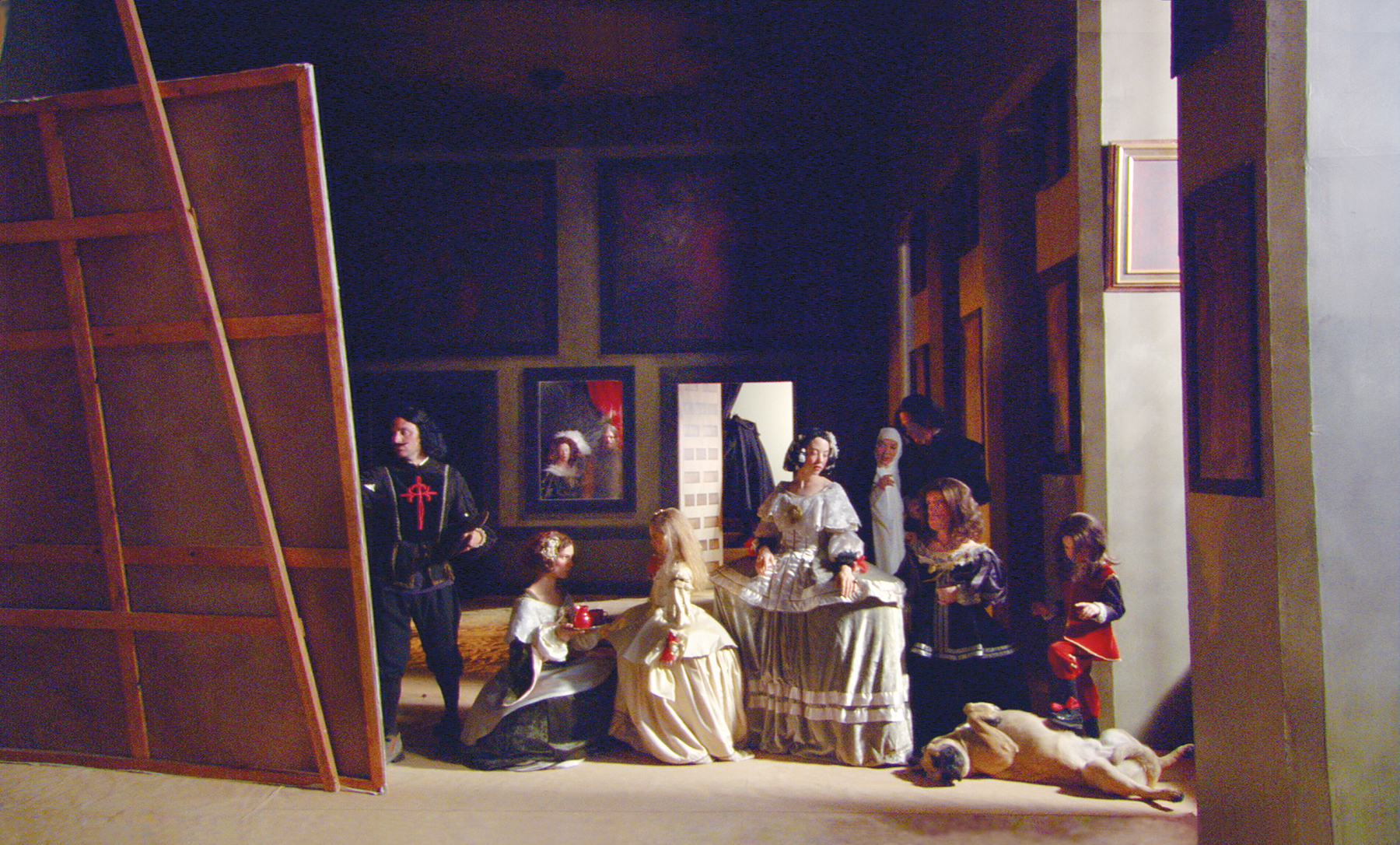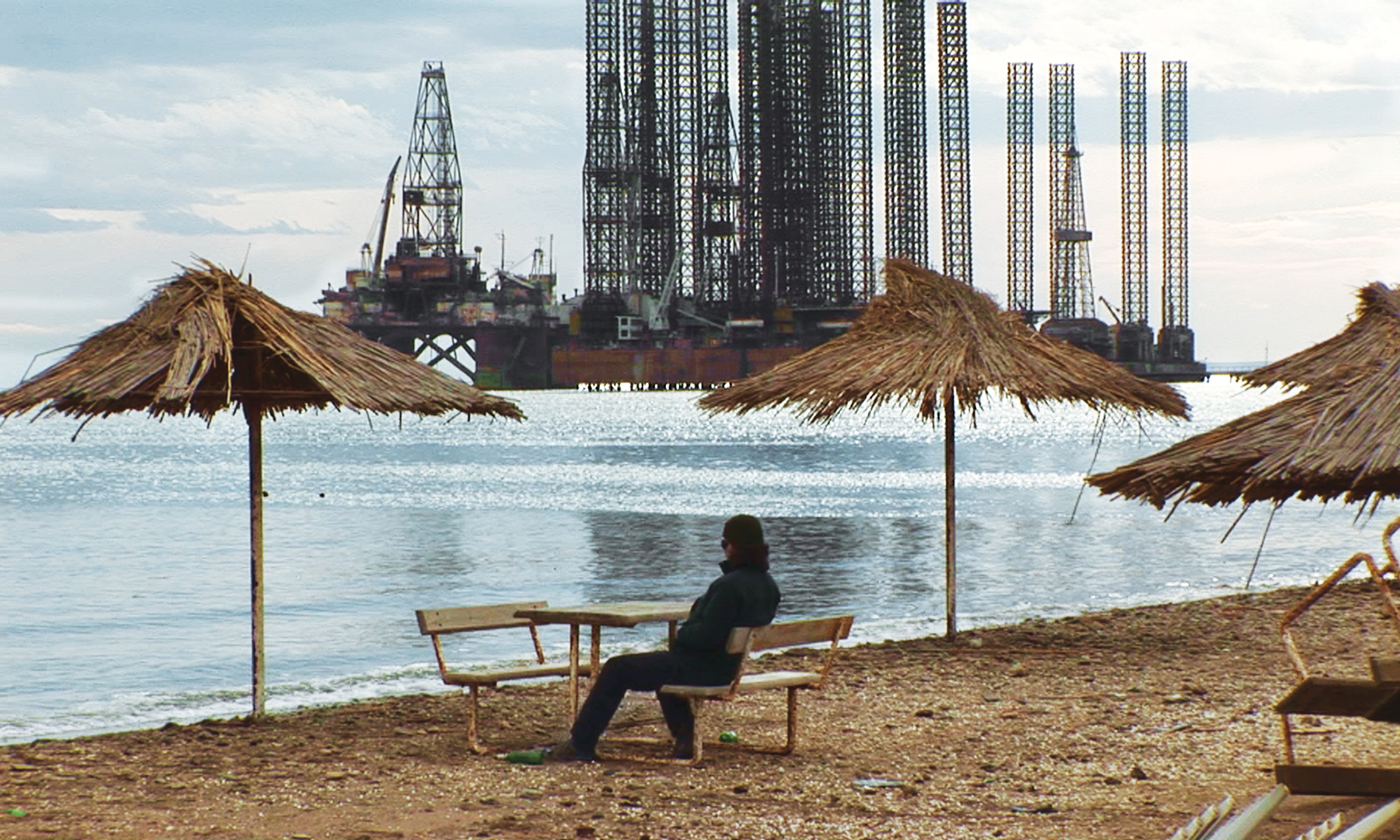« Features
Interview with Eve Sussman
Since the 2004 Whitney Biennial premiere of the video 89 Seconds at Alcázar-a meticulous reconstruction of the Velázquez painting Las Meninas using live actors-artist Eve Sussman and Rufus Corporation have become known for projects that use contemporary mediums and techniques to redefine iconic artworks. In this interview, we talk with Sussman about 89 Seconds and her 2006 film The Rape of the Sabine Women, her fascination with surveillance and fragile utopias, and her company’s most recent piece whiteonwhite:algorithmicnoir, which will premiere this September at the Toronto International Film Festival as part of Future Projections, and open September 15 at Cristin Tierney Gallery in New York.
By Jeff Edwards
Jeff Edwards - You studied photography and printmaking at Bennington College in the early 1980s, but you’re known for interdisciplinary works in which video, installation, performance, and digital media come together. How did this shift come about?
Eve Sussman - All things I do now I’ve taught myself. The transition was organic. I’ve used cameras from the time I was in high school: Super 8 cameras, cheap surveillance cameras, things you can put your hands on for very little money. There was a point where that film/video material started combining with installation. In my first New York solo show at Bronwyn Keenan gallery in the 1990s, I put surveillance cameras in the air shaft of a building on Broadway. The piece was called Ornithology, it surveilled pigeon life around the building. But there was also a big installation element. We built a tower in the airshaft and a ramp that went out the window of the top floor leading to an observation deck that viewers could climb out on. That’s an example of the crossover of live-feed video and installation. Over time there was less installation and a lot more film/video. In order to shoot 89 Seconds at Alcázar (2004), we had to build the room that you see in Las Meninas, so that moved the work back in the direction of installation.
J.E.- Your approach seems to be very attuned to mass media and the possibilities that technological society offers. Do you think that artists should dialogue with their own context, which means using video, i-phones, cameras, etc.?
E.S.- I think artists should do what they want. It’s great to work with pencil on paper, and it’s great to work on an iPhone. They’re both tools. Sometimes I get sick of all these computers, but one becomes easily enamored with what they can do. We’ve created a movie now called whiteonwhite:algorithmicnoir that’s edited live by computer. Jeff Garneau wrote the computer algorithm to do that for us. But, I still admire traditional filmmaking.
TRANSLATING FROM PAINT TO VIDEO
J.E.- Las Meninas is a highly enigmatic piece, not only within Velázquez’s oeuvre but also in art history in general. What made you go for a contemporary re-interpretation of it?
E.S.- I think Las Meninas picked me. You walk into the Prado, and you are overtaken by that artwork.
J.E.- Were you specifically interested in pursuing classical painting as a source of inspiration?
E.S.- No, not at all. My interest in surveillance shaped 89 Seconds at Alcázar. Las Meninas is a big surveillance. If you extrapolate out, and you continue to surveil that space, where does it go? You have to figure out the choreography and the movement, before and after. I’m really interested in cinematic history: the history of how you tell stories, how you employ narrative, how you choose to work with language, or not. Ironically - and you would not know this from watching such a highly stylized, choreographed piece - 89 Seconds was influenced by my experience shooting cinéma vérité, with watching what’s going on in front of you, with observing everyday banalities. That sort of observation can take place anywhere: in a museum, on a street, in a supermarket. I’m not making work about painting. I am inspired by paintings but it’s often a disappointment to people to find out that I’m not especially interested in painting.
HISTORICAL IMAGES, TIMELESS DILEMMAS
J.E.- When you reference art history in your works, are you attempting to take old images and infuse them with new meaning that’s relevant to our times?
E.S.- I am less interested in our specific ‘times’ and more interested in ubiquitous anti-temporal problems within which we are all trapped. So many of the issues of the day are the result of human nature - greed, possessiveness, fear, anxiety. Whether it’s a group of actors playing parts, or that group as their real selves, there are undeniable truths present in the dynamics and psychological events that go on between people. If there is a commentary, it’s about things that are timeless - human emotions are not improved with technology or in the history of art.

Dog Rolls, 2004. Video still from 89 seconds at Alcázar. All images are courtesy of Eve Sussman | Rufus Corporation.
J.E.- Your interpretation of Las Meninas was very precise in its attention to historical detail. How did you envision the recreation of the past in this work, and what were the sources you consulted?
E.S.- In 89 Seconds, we tried to build a room that looked like the space of the painting, and our costume designer, Karen Young, worked really hard to create costumes that were strongly reflective of what you see in that painting. At the same time, none of it was real. It was clearly reconstructed and was about the power of suggestion. We have no idea how people lived in the Baroque court in Spain. We can’t understand what it would have been like, how they would have spoken, how they would have moved. You can put on those clothes and it sort of starts to indicate how you would walk across a room, but it’s really all conjecture on our part.
I also researched the architecture of the palace, and cultural information about how people lived. The woman who everyone thinks is a nun was actually a widow. Widows became like nuns once their husbands died. That kind of information informed decisions about an actor’s demeanor, but it’s still invented, and it’s still about the present. The research enabled a mental and physical image for the actors. They needed something to base their characters on, and they came up with personas and stories about who they were. People think the actors look so much like the characters in Las Meninas, but if you matched them up side-by-side, you would see they don’t look alike at all. The power of suggestion makes you believe that they do.
J.E.- One of your other works that seems very political is The Rape of the Sabine Women (2005), based partly on a 1799 painting by Jacques-Louis David. Although it was based in history, David’s painting reflected the revolutionary times in which he lived. How does your translation of David’s work reflect our own times, and what role does the change of setting to the 1960s play in this?
E.S.- I don’t think any of our initial motivations were overtly political. I would say they’re overtly personal. That said, within the personal, there’s always the political. With Rape of the Sabine Women, we were interested in the myth, so we based the film on that, more than on David’s painting. It seemed obvious to place it in the early 1960s, with such specific gender roles and conformity that preceded the radical changes toward the end of the decade. That moment was at the forefront of the second wave of feminism.
I was initially interested in the psychological dynamics of putting this group of actors together. Most of the original group who made 89 Seconds returned to make The Rape. In Athens we hired a group of Greek actors and everybody got thrown in this pot and had to deal with the psychological challenges of an environment that was a mix of fiction and reality. This real/unreal environment was most pronounced in the improvisations we did at Valsamakis house - a famous International Style house that overlooks the Aegean, built in 1961. The house and its inhabitants became an allegory for the heyday of Rome - a lavish summer house on a cliff, with people living the high life, as everything’s about to fall apart. The message is rather obvious: be careful what you wish for. That perfect lifestyle, that “better living through design” idea that’s also a strong element in contemporary life, is simultaneously full of possibility and failure. That’s not specifically political; it’s a timeless statement.
ENVISIONING THE FUTURE THROUGH THE PAST
J.E.- Let’s talk a little about your ongoing multimedia project whiteonwhite:algorithmicnoir, which was at least partly inspired by the utopianism of Kazimir Malevich. At the risk of reducing an incredibly complex project to overly simplistic terms, how does whiteonwhite reflect back on his ideas, and on the utopian ideals of Modernism?
E.S.- We keep referring through texts and images to the quest for the perfect place and the failures inherent in that. I like to think of this material as “archival footage from the future.” We shot a lot of grainy Super 16 film at sites built 60 years ago. The Soviet government created a master plan for places where it was almost untenable to live. Our main location was a town near the Caspian, on the edge of the desert, where there was no fresh water. We took these modernist visions of planned societies, filmed them in a way to make them look almost archival, and fit them into our retro-noir science fiction story that’s saying, “Well, what if this is the future?”
Designing the future is a double-edged sword. We were shooting in post-Soviet Asian countries, where to large degree everyone is educated, everyone has a place to live, everyone has healthcare, and people’s quality of life is not bad. On the other hand, there were massive environmental disasters and indigenous culture was almost wiped out. It’s not that it across-the-board didn’t work, it worked and it didn’t work.
J.E.- I’d like to end with a pretty broad question: how do you envision the idea of ‘the image within the image’ that seems to be so characteristic of our society? Is your own re-engineering of historical images a version of this?
E.S.- Your suggestion of ‘the image within the image’ is great since so many of us carry phones on which we create images within the bigger picture of our everyday lives. One banal image inside another - it’s quite poetic. The little screen that talks back to us is a picture from the fiction of our youth.
The way we picture the future is a fantasy, in the same way it’s fantasy for us to envision the Baroque court of Velázquez. Yet, the images of the future that we create completely inform us. In every burgeoning Asian futuropolis, you see the requisite sci-fi baubles that Norman Foster builds. Those baubles look like The Jetsons and Star Trek, and there’s a reason they look like that. They’re like the cartoons that we grew up with as kids. I can’t help wondering what they would look like if they didn’t look like that.





































